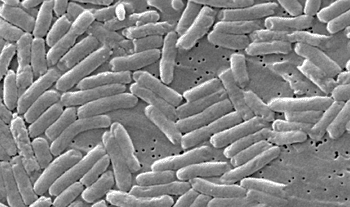Faster Method Identifies Salmonella Strains
By LabMedica International staff writers
Posted on 18 Jun 2013
A sequence-based subtyping approach may be able to reduce by more than half the time it takes health officials to identify Salmonella strains.Posted on 18 Jun 2013
Rapid, efficient, and accurate methods are required for the identification of specific strains of serovar Newport during outbreak allowing epidemiological investigators to identify the exact strains of Salmonella that make people ill and to more quickly find and eliminate the source of the disease.

Image: Scanning electron micrograph of Salmonella bacteria (Photo courtesy of US Centers for Disease Control).
Microbiologists at the Pennsylvania State University (White Oak, PA, USA) developed a novel approach to identify strains of Salmonella enterica subspecies enterica serovar Newport. The method focuses on two virulence genes and two novel regions of Salmonella DNA called clustered regularly interspaced short palindromic repeats, or CRISPRs. The scientists devised a method of multivirulence-locus sequence typing, or MVLST, that can detect strain-specific differences in the DNA at these four locations. The method is designated as CRISPR-MVLST.
A total of 84 clinical isolates of serovar Newport were obtained and selected systematically over five years. The isolates received closest to the 1st and 15th of each month from 2007 to 2011 were selected to represent an unbiased collection of human clinical isolates. The investigators used polymerase chain reaction amplification (PCR), DNA sequencing, and sequence analysis and sequence type assignment to study the isolates. Toward the end of the project, they applied their analysis to a Salmonella outbreak, associated with tomatoes that occurred in Pennsylvania in summer 2012 in which 37 people got sick.
The authors concluded that the advantages of CRISPR-MVLST are the potential automation of the procedure, the ability to conduct this analysis in a high-throughput manner, and that sequence data are inherently more manageable for downstream applications such as phylogenetic and evolutionary analyses than are pulse field gel electrophoresis (PFGE) data.
Nikki Shariat, PhD, the lead author of the study said, “Right now, public-health laboratories use a technique called PFGE, to subtype Salmonella strains, and it normally takes one to three days to identify a specific strain. The technique we devised often takes just one day. Fifty percent of bacteria have CRISPR regions and using these for identification has been done with quite a few bacteria, such as Mycobacterium tuberculosis, as well as with some that cause foodborne illness, such as Campylobacter and Escherichia coli.” The study was published on May 15, 2013, in the Journal of Clinical Microbiology.
Related Links:
The Pennsylvania State University













